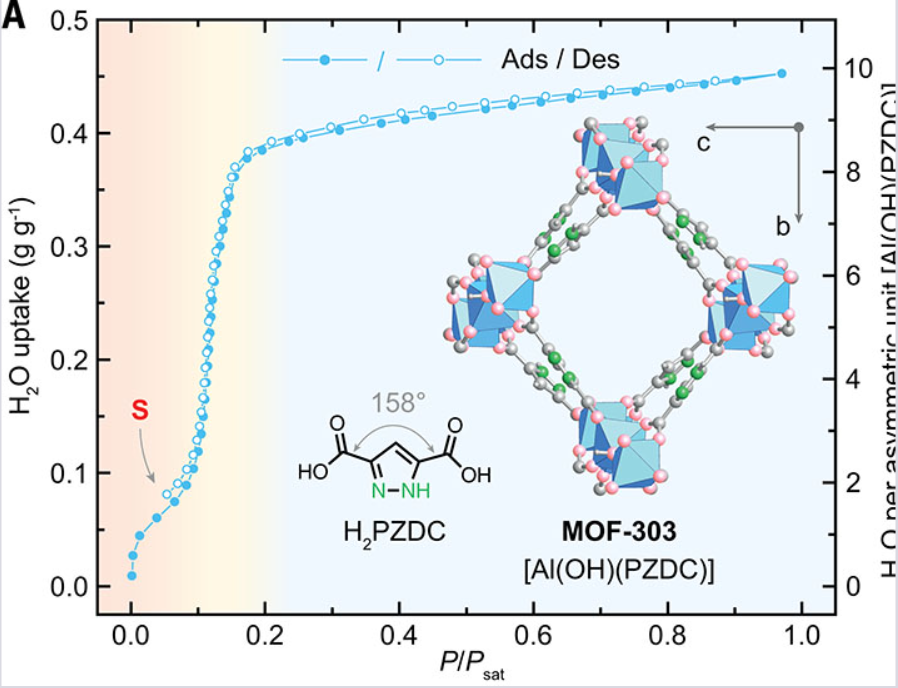Home >
News > Evolution of water structures in metal-organic frameworks for improved atmospheric water harvesting
Evolution of water structures in metal-organic frameworks for improved atmospheric water harvesting
Summary:
The authors from University of California, Berkeley, Humboldt-Universität zu Berlin, University of Chicago, etc. developed multivariate metal-organic frameworks (MOFs) including MOF-303 and MOF-333 with tunable water adsorption properties, achieving improved water productivity, adjustable regeneration temperature/enthalpy in atmospheric water harvesting.

Background:
1. To address the lack of full mechanistic understanding of water uptake behavior in MOFs (though water positions in some MOFs are identified via diffraction, filling sequence of water-binding sites is unclear), previous researchers studied water adsorption in MOFs but failed to clarify the evolution of water structures and precise regulation of water-harvesting performance.
2. The authors proposed using single-crystal X-ray diffraction (SCXRD) and density functional theory (DFT) to decipher MOF-303’s water-filling mechanism, and adopted a multivariate MOF strategy to modify pores, realizing precise tuning of water-harvesting properties.
Research Content:
1.Synthesis:
The authors synthesized MOF-303 {[Al(OH)(PZDC)]} using 1H-pyrazole-3,5-dicarboxylic acid (H₂PZDC) and Al sources; synthesized MOF-333 {[Al(OH)(FDC)]} with 2,4-furandicarboxylic acid (H₂FDC); and prepared 9 multivariate MOFs by adjusting the ratio of PZDC²⁻ to FDC²⁻, via dissolving linkers in NaOH solution, adding Al salt solution, incubating at 100°C, then washing and drying.
2.Characterizations:
1) BET: The 9 multivariate MOFs have BET areas of 1280–1360 m²/g, pore volumes of 0.48–0.51 cm³/g, and pore diameters of ~9.4 Å.
2) SEM tests show homogeneous elemental distribution in multivariate MOF crystals, with no single-linker MOF impurities.
3) TGA: The MOFs are stable up to 375°C under N₂ and 325°C under air; SCXRD shows MOF-303’s unit cell b-axis changes from 14.5037(6) Å to 16.7259(7) Å upon water adsorption.
3.Application:
In atmospheric water harvesting, MOF-333 has a steep adsorption step at 22% RH; multivariate MOFs with higher FDC²⁻ content have lower desorption temperatures (reduced by up to 10°C) and higher working capacity (increased by up to 15%); "4/4" MOF retains ~97% capacity after 2000 adsorption-desorption cycles.
4.Mechanism:
SCXRD and DFT reveal MOF-303’s water-filling mechanism: first water binds to polar linkers, then forms clusters, cluster chains, and finally a water network; substituting PZDC²⁻ with less hydrophilic FDC²⁻ weakens water-linker interaction, modulating adsorption behavior without compromising pore properties.

Outlook:
This research clarifies MOF-303’s water-uptake mechanism, realizes precise regulation of MOF water-harvesting performance via multivariate strategy, and transforms water-harvesting material development from trial-and-error to precision design, promoting the application of MOFs in arid area water acquisition.
Evolution of water structures in metal-organic frameworks for improved atmospheric water harvesting
Authors: Nikita Hanikel, Xiaokun Pei, Saumil Chheda, Hao Lyu, WooSeok Jeong, Joachim Sauer, Laura Gagliardi, Omar M. Yaghi
DOI: 10.1126/science.abj0890
Link: https://www.science.org/doi/10.1126/science.abj0890
The above review is for academic progress sharing. For any errors or copyright issues, please contact us for correction or removal.

